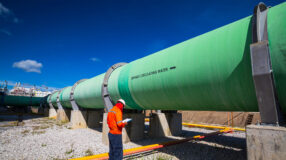Dear Secretary Chu:
We are writing to you to voice the strong support of the Interstate Natural Gas Association of America (INGAA) for the findings of the recent study on liquefied natural gas (LNG) exports by NERA Consulting.
The report, conducted on behalf of your agency, succinctly outlined the benefits of overseas sales of LNG. As the report stated, “In all of the scenarios analyzed in this study, NERA found that the U.S. would experience net economic benefits from increased LNG exports.”
The report also found that the “net result” of LNG exports would be “an increase in U.S. household’s real income and welfare.” These are critical findings for you to consider as your department reviews both the overall U.S. policy on LNG exports as well as the specific applications for export facilities now pending before your agency.
As the NERA report makes clear, LNG exports offer new opportunities for the American economy in general and the natural gas industry in particular. With those opportunities, however, comes the need for new energy infrastructure. As the NERA report suggests, LNG exports could provide a valuable and important new source of capital for these projects.
The NERA study stated that “exports of natural gas will improve the U.S. balance of trade and result in a wealth transfer into the U.S.” This would be an important step toward reducing the trade deficit that has existed in our economy for many years. Beyond these balance of trade implications, the report found LNG exports could attract overseas capital to support investments in domestic energy infrastructure, providing “another form of wealth transfer into the U.S.”
Liquefaction facilities were singled out by the NERA report as likely investments for foreign capital. However, it is clear that overseas buyers also would be interested in a robust and reliabl
U.S. natural gas industry at all levels. That interest easily could lead to additional capital for strengthening gathering, transmission, storage and processing facilities – all critical links in the supply chain needed to get domestic gas to overseas buyers. And, as the NERA report also observes, exporting LNG also will cause “income to owners of natural gas resources (to) increase,” providing additional resources for supply expansion and needed infrastructure development.
Recent studies conducted by The INGAA Foundation, Inc. demonstrate the magnitude of those infrastructure needs. The Foundation’s June 28, 2011 report, “North American Natural Gas Midstream Infrastructure Through 2035: A Secure Energy Future” evaluated the need for additional transmission, gathering, compression, storage and processing capacity over the period 2011 through 2035. The report’s reference case, using the most likely scenario for market development, found that more than $205 billion in capital investments would be required through 2035, with average annual expenditures of $8.2 billion.
Nationwide, The INGAA Foundation estimated that almost $98 billion in transmission mainline projects, $30 billion in lateral projects, $42 billion in gathering lines, $9 billion in compression projects, $5 billion in storage fields, and $22 billion in additional storage capacity would be needed by 2035.
These are conservative estimates. The report noted that several “big market movers,” including LNG exports, could increase infrastructure needs, thus making the need for additional capital even more urgent.
A full copy of the report can be found at the following link:
http://www.ingaa.org/Foundation/Foundation-Reports/Studies/14904/14889.aspx
Natural gas markets are linked across North America through numerous pipeline interconnects. Thus, these large midstream capital requirements span the entire range of natural gas infrastructure and extend to not just all regions of the U.S, but to Canada and Mexico as well. For example, at least three LNG export projects have been proposed in Canada. If these investments take place, the economic benefits of LNG exports will be realized by Canada, not the U.S. The current regulatory uncertainty around LNG exports in the U.S. prevents American LNG export developers from competing in the global LNG market on a level playing field.
The economic impact of midstream investment will be felt far beyond the natural gas industry. Another INGAA Foundation study, completed in February and building on the previously cited infrastructure study, found that new capital investment in midstream development would be a significant contributor to job and income growth, total economic output, and tax revenues.
The study found investments from 2012-2035 would support an annual average of more than 104,000 jobs, at an average worker income of more than $56,000. Additionally, the investments
would account for nearly $425 billion in total economic output during the period, generate nearly $17 billion in state and local tax revenues, and produce almost $31 billion in federal tax revenue. The text of the report can be found at the attached link:
http://www.ingaa.org/Foundation/Foundation-Reports/Studies/17731/EconomicImpactReport.aspx
The “natural gas revolution” has been described as the most significant domestic energy development in decades. Its continued progress is highly dependent on development of additional facilities to gather the supplies and get them to market. We agree with the NERA report’s view that allowing LNG exports will produce a valuable new source of capital for domestic infrastructure improvements.
Similarly, we agree with the NERA report’s findings that these exports will strengthen America’s natural gas industry and generate additional income for producers. With that income, the U.S. natural gas industry will be better positioned to undertake the improvements needed to make this clean, efficient, affordable and abundant fuel available to American consumers and to markets in other countries for many years to come.
We urge the Department to favorably consider the NERA report’s findings and approve the pending export applications.
Sincerely,
Donald F. Santa
President and CEO
Interstate Natural Gas Association of America





